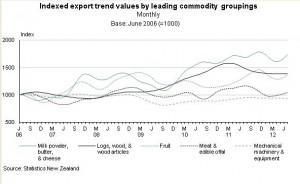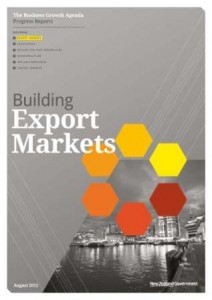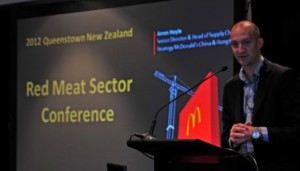Hyperglobalisation, China, mega cities, urbanisation and water are some of the big issues that will play their part in the future of the New Zealand and global export meat industry, according to several Red Meat Sector Conference speakers.
 In his presentation about the political and economic environment facing the industry, Colin James of the Hugo Group said it is becoming more and more difficult for a nation to act independently these days. ‘Hyperglobalisation’ refers to the increasing global interdependence and interconnectedness, which make protection from global economic forces more difficult, he said.
In his presentation about the political and economic environment facing the industry, Colin James of the Hugo Group said it is becoming more and more difficult for a nation to act independently these days. ‘Hyperglobalisation’ refers to the increasing global interdependence and interconnectedness, which make protection from global economic forces more difficult, he said.
We can expect more of the same over the next 20 to 25 years, he explained. “It’s going to need a fair amount of resilience.”
Water, along with fossil fuels, will be the big issues, he predicts. Multinationals are rebranding and adopting a “fresh, clean, natural” stance rather than ‘clean, green’ approach to capitalise on the emergence of an affluent middle class in emerging markets. This growing middle class around the globe is calculated to encompass more than 210 million new households with income of US$20,000 or more by 2025, which he believes New Zealand is well placed to serve.
Four percent global GDP growth predicted
New Zealand’s top ten trading partners are projected to grow roughly four percent a year in 2012 as weighted by the goods trade. “Modest, but not boom time,” James commented.
 Four percent in global GDP growth also stood out for Richard Brown of market research company GIRA, who admitted to being surprised that the forecasts were so positive. The leader is China, whose GDP is anticipated to grow in 2011/2012 by 8.5 percent, “not as good as expected but still OK”, followed by Indonesia (6.5 percent). He anticipates similar growth in 2012.
Four percent in global GDP growth also stood out for Richard Brown of market research company GIRA, who admitted to being surprised that the forecasts were so positive. The leader is China, whose GDP is anticipated to grow in 2011/2012 by 8.5 percent, “not as good as expected but still OK”, followed by Indonesia (6.5 percent). He anticipates similar growth in 2012.
In his detailed look at the outlook for various meats, including beef and sheepmeat, he said that global prices for meat are generally, “fundamentally more exciting than they have been.” He was reassured with the direction of the trends, which he said were, “very good news for the producing sector.”
In 2011, prices had gone up boosting producer morale, because total global meat production was down – largely as a result of the outbreak of the pig disease PRRS in China, Brown explained. “What that illustrates is the Chinese effect on global trade is profound.”
This point was echoed in a later presentation from McDonald’s senior director and head of strategy for China and Hong Kong Arron Hoyle, who said that China is having a dramatic effect on global commodities.
“We don’t sell beef at McDonald’s, we sell a burger, so other commodities have to be taken into account.”
Rise of the dragon
Both James and Brown pointed to the current difficulties in the US and in Europe, which is facing big problems with the Euro. Europe had a “spectacularly fragmented meat industry,” Brown said and pointed to problems with the region’s biggest meat company, Vion, which is now in trouble after a period of rapid acquisition. This reflects a lower rate for now for global corporate processor consolidation “with a long way to go and an unproven success record.”
Arron Hoyle also pointed in his presentation to the ‘rise of the dragon’, the lean away from the west to the East, with McDonald’s choosing to target consumers in what it calls the APMEA (the Asia Pacific, Middle East and East Asian) region.
Unprecedented urbanisation
Hoyle talked about urbanisation in those emerging markets, such as China and India, “like we’ve never seen it before.” In the APMEA countries populations are moving from rural to urban settings in a similar manner to Britain’s Industrial Revolution, “but it’s happening 20 times faster and involves about 800 times more people,” he explained.
“We’re living in an era where we’re seeing different dynamics to the previous 50 years,” he said, adding that volatility will be more extreme than ever before.
‘Mega Cities’, those with populations of more than 10 million, are on the rise and currently count Shanghai, Mexico City, Sau Paolo, Beijing, Mumbai and Delhi as the top six.
“In addition, emerging market cities will be a key driver of global food demand with key 440 cities identified across Asia. With this explosion in urbanisation we see many ‘tier two cities’ with populations over one million evolve: By 2020 it is projected China will have 221, India 50, Indonesia 15 and Korea nine.”
With this trend comes a “massive” transport and infrastructure need, but also a forecast quadrupling of per capita of GDP by 2020, said Hoyle.
“It’s a world of opportunity for years to come,” he said cautioning that it also comes with higher rents and increased pressure on costs for McDonald’s stores or other businesses that target Asia as a key future growth driver.
This article appeared in Food NZ magazine (August/September 2012).
 Meat and edible offal is still trending upwards in value since its recent low point of February 2012, but is still 11 percent lower than its record high point in July 2011, according to SNZ.
Meat and edible offal is still trending upwards in value since its recent low point of February 2012, but is still 11 percent lower than its record high point in July 2011, according to SNZ.








